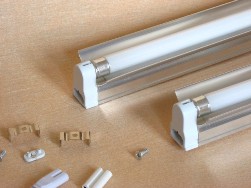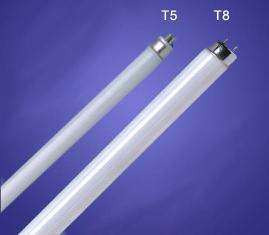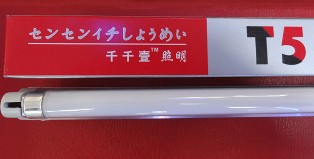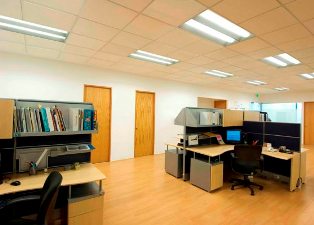Categories: Featured Articles » Sources of light
Number of views: 59330
Comments on the article: 2
T5 fluorescent tubes: a new look for familiar fluorescent tubes
 Market appearance T5 fluorescent lamps marked a new era in the development of gas-discharge light sources. With a small bulb diameter, these lamps have very high efficiency and a long service life. But the main news was their complete incompatibility with existing lighting fixtures. Is such a decision justified in relation to hundreds of millions of luminaires for T8 lamps, and what are the reasons for this approach?
Market appearance T5 fluorescent lamps marked a new era in the development of gas-discharge light sources. With a small bulb diameter, these lamps have very high efficiency and a long service life. But the main news was their complete incompatibility with existing lighting fixtures. Is such a decision justified in relation to hundreds of millions of luminaires for T8 lamps, and what are the reasons for this approach?
The electrical and structural parameters of T5 lamps are such that it is impossible to ignite or maintain operating parameters using traditional ballasting equipment (ballasts). For example, the operating voltage of an 80 W lamp is 152 V, and for a 35 W lamp at a current of 0.175 A, the operating voltage is even equal to 205 V. With a network voltage of 220V, no electromagnetic ballasts can provide such operating parameters - the lamps will inevitably go out.
Therefore, T5 lamps are designed to operate exclusively with electronic ballasts. Electronics allows you to realize another important advantage: high-frequency lamp power. Features of the inclusion and power of lamps have become the main reason for the rejection of the use of existing fixtures.
The second reason is that with a decrease in the diameter of the lamp increases sharply surface glow. To eliminate glare, it is necessary to change the reflector and diffuser of the lamp. Another phenomenon that manifested itself when trying to install lamps in lamps with traditional reflectors is the appearance of the rainbow effect. It consists in the appearance of colored spots and stains on the surface of anodized aluminum and distortion of the color rendering of the lamp.
In T5 lamps, this phenomenon was successfully dealt with by reducing the oxide layer of aluminum or, even, by spraying a thin layer of silver, which completely eliminates the iridescence of reflected light.
All these reasons forced the lamp manufacturers to resize the sources, so that there was no temptation to install new lamps in lighting devices not intended for them. But the temptation to use luminaires for T8 lamps was so great that several companies began to offer ignorant buyers an adapter block for adapting T5 lamps to old luminaires.
It includes an adapter from the base G13 to G5 and a mounting plate with electronic ballasts. To convert a luminaire, remove the old lamp holders, ballasts and compensating capacitors. Instead, the adaptation unit is mounted. If we leave aside the complexity of such an operation, then the new lamps in the old design will distort the directional pattern of the lamps. They will create uneven lighting of rooms, and will have a high glare effect. And alteration of several hundred fixtures in large office premises will fly into a penny.
Therefore, new lamps can only be used in conjunction with a luminaire designed and optimized for this source. In the USA, Germany and Sweden, more than 30% of the luminaire fleet has already been replaced by T5 lamps, and this figure is constantly increasing. The situation is completely opposite in the CIS countries: there practically no such lamps have been used yet.
In addition to the lack of funds to replace completely suitable lighting devices, there is another factor that stops the widespread use of T5 lamps. This is the high sensitivity of new lamps to ambient temperature. At temperatures below 0, the luminous flux of T5 lamps falls 2 times. This limits their use only to heated rooms.
For those who decided to install modern luminaires for T5 lamps, there is one more difficulty: you need to carefully familiarize yourself with the type of electronic ballasts in the luminaire. They are even different for lamps of the same power: some are optimized for maximum efficiency and are designed for lamps of the "NOT" type (OSRAM company designation), others for the "HO" type - maximum luminous flux. Such nuances scare away some consumers who find it difficult to navigate the abundance of types and applications of modern lamps.
Unexpected fans of the T5 lamp were found in the face of fans of breeding aquarium fish. Specialized sites are full of descriptions of lamps for these lamps with rave reviews. T5 lamps are also suitable for accelerating plant growth. The possibility of obtaining very high illumination per unit area of the luminaire makes the use of highly efficient lamps cost-effective in greenhouses.
But to mass demand for T5 lamps in our countries is very far. Lamps themselves, and lighting devices for them, are 3-4 times more expensive than usual ones. Therefore, in addition to individual enthusiasts and special applications, they are unlikely to find supporters in the foreseeable future.
See also: The history of the creation and development of fluorescent lighting
See also at bgv.electricianexp.com
:



